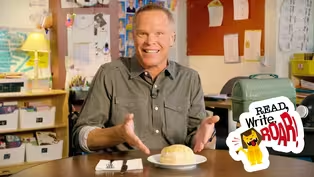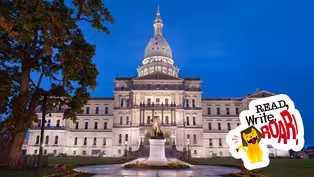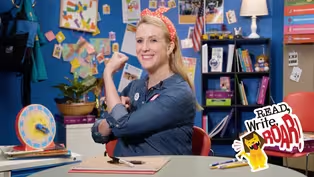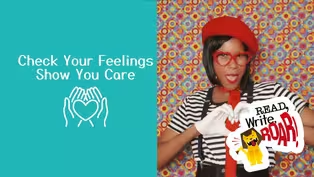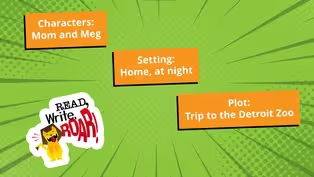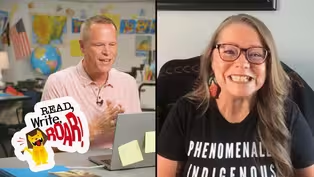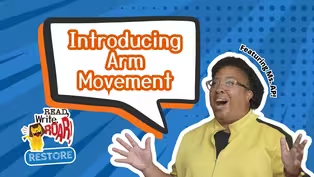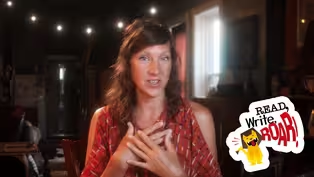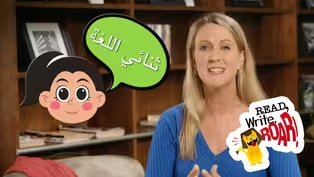Read, Write, ROAR!
Let's Talk Together - Michigan's Languages
Season 1 Episode 1006 | 26m 46sVideo has Closed Captions
Learn all about languages you might hear in Michigan!
Learn about Michigan's 2nd most spoken language, Arabic. Then learn about one of Michigan's first langauges, Anishinaabemowin.
Problems playing video? | Closed Captioning Feedback
Problems playing video? | Closed Captioning Feedback
Read, Write, ROAR! is a local public television program presented by Detroit PBS
Read, Write, ROAR!
Let's Talk Together - Michigan's Languages
Season 1 Episode 1006 | 26m 46sVideo has Closed Captions
Learn about Michigan's 2nd most spoken language, Arabic. Then learn about one of Michigan's first langauges, Anishinaabemowin.
Problems playing video? | Closed Captioning Feedback
How to Watch Read, Write, ROAR!
Read, Write, ROAR! is available to stream on pbs.org and the free PBS App, available on iPhone, Apple TV, Android TV, Android smartphones, Amazon Fire TV, Amazon Fire Tablet, Roku, Samsung Smart TV, and Vizio.
Providing Support for PBS.org
Learn Moreabout PBS online sponsorshipMore from This Collection
Learn the literacy skills every 4th and 5th grader needs while exploring what makes Michigan unique.
Tasty Michigan Treats - Michigan's Unique Foods and Snacks
Video has Closed Captions
Learn about Michigan's magical foods! (26m 45s)
What's Up With the Weather? - Michigan's Climate
Video has Closed Captions
Learn all about Michigan's climate. (26m 46s)
Making Michigan - Lessons in Michigan History
Video has Closed Captions
Take a dive into the history of Michigan. (26m 45s)
Video has Closed Captions
Learn how to use multiple sources and how narrative text works! (26m 46s)
Providing Support for PBS.org
Learn Moreabout PBS online sponsorship- On "Read, Write, ROAR!," learn about Michigan's second most spoken language, Arabic.
Then, learn about a language older than Michigan.
Let's go Read, Write, ROAR!
- [Announcer] This program is made possible in part by: The state of Michigan.
And by: And by viewers like you.
Thank you!
(upbeat bright music) (gentle music) - Have you ever read an author's note at the end of a novel or picture book?
I'm Mrs. DeFauw and I love reading author's notes because they provide interesting facts.
Sometimes these author's notes are called an afterword, which is where I discovered Christopher Paul Curtis's encouragement at the end of his novel, "Bud, Not Buddy."
Mr. Curtis encourages readers to listen to family members' and friends' stories.
I love to gather stories and learn from people's different experiences.
People's experiences are similar and different from one generation to another.
Today, we will learn one interview strategy for gathering our families and friends stories to create intergenerational stories.
Intergenerational is a long word.
Let's break up that word into syllables or word parts.
IHN-TEHR-JEHN-EHR-AY-SHUN-UHL.
I counted seven syllables.
That's definitely a multi-syllabic word.
A generation is a group of people who were born around the same time.
Our grandparents are one generation.
Our parents are another generation.
And we are a part of our own generation.
Intergenerational includes the Latin prefix, inter-, which means between, and the Latin suffix, -al, which makes the word an adjective.
So it can be a describing word.
As a writing teacher, my students have shared so many family stories with our writing community.
I love reading the dialogue in their stories because when readers hear the conversation, the stories come alive.
The spoken words are the dialogue.
Whenever somebody speaks, we see quotation marks around words which tell us when dialogue is taking place.
I think of this as a smiley face with dimples.
Whatever is spoken is framed with quotation marks.
I'm a teacher in Dearborn, Michigan.
Many people who live in Dearborn have roots in Arabic speaking countries.
Did you know Arabic is the national language in 25 countries in the Middle East or Northern Africa?
Many of my students are bilingual, which means they can speak more than one language.
When my bilingual students write their stories, I encourage them to write the dialogue and provide some specific details in their first language.
One of my former students, Ms. Joanne Naba, speaks Arabic and English.
When she shares stories with her family, she speaks sometimes using Arabic, sometimes English, and sometimes both languages in the same sentence.
If you and your family are also bilingual, I bet you can relate.
I am excited to meet with Ms. Naba and two of her daughters at the Mardigian Library at the University of Michigan, Dearborn.
Ms. Naba's daughters are talking with her to learn about a favorite moment with their Jadda, which means grandma in Arabic.
Many Arabic speaking cultures say the word grandma differently because of different dialects.
Depending on where a family is from, they may use the name, Sittee, Teta, Bibi or Jadaty.
There can be even more ways to say grandma in Arabic.
Isn't that fascinating?
Let's listen in.
- Mama, what's an early memory of you and Teta from your childhood?
- Oh, one of my early favorite memories is when Teta read to me and your Khalos.
She'd buy picture books and read to us all the time.
She made it a part of our daily routine, I would say, (person speaking in foreign language) and let's pick out stories and read together.
And she would have a few books already laid out for us to pick.
I'd love to do that too.
You know how much I love to buy books and read them to you and your sisters all the time.
- Hey mama, what is the memory of you and Teta laughing together?
Great question, Sadda.
So laughing is something we did a lot when I was younger, so the stories are endless.
However one time, Teta tried to teach me how to cook our favorite traditional dish when I was a teenager called waraq anab.
I remember we were standing in the kitchen and Teta was teaching me how to properly roll the grape leaves.
I had to add enough hashweh not to overstuff it, but also enough to fill it well.
Hashweh was made of rice and ground beef and (indistinct) and plenty of freshly squeezed haamid.
She'd say, "Yallah, Joanne, try your best.
"Try to keep a serious look on the face."
It's quite the funny story because I wasn't always the easiest to work with, so I kept over stuffing it and I had the hardest time moving.
They were always too loose.
Teta spent half the time laughing at me.
And you know Teta, when she starts laughing at something really funny, it's hard to get her to stop.
Tears were rolling down her face.
It actually took me years to learn how to make it, and I still prefer someone else to do it.
But memories like this make my heart full every time I enjoy a favorite dish like waraq anab, because I remember the moments I shared with Teta in preparing it or attempting to prepare it.
- I enjoyed listening to this conversation with Ms. Naba and her daughters today.
We have the power to collect our own family's and friends' intergenerational stories.
I encourage you to ask the people you love questions about their experiences.
Through the power of interviews or simply through conversation, we learn from individuals' voices and experiences.
You never know where your next writing idea might come from.
Collect oral stories and choose to write them down.
Such stories are intergenerational treasures.
(upbeat music) (upbeat music) - I'm Ms. AP, here to help restore your energy.
Let's start with our warmup.
We are gonna be running in place by the count of 10.
Ready?
Go.
One, two, three, four, five, six, seven, eight, nine, 10.
Good job everyone.
Now that we warmed up our bodies, we are ready to exercise.
Today we are going to continue to work on jumping jacks.
So get ready.
I would like you to use your ready position, standing up tall like a pencil, feet together, arms at your side.
But this time I would like you to use your fist on both sides of your body.
Once in that ready position, I am going to jump out, arms up, hands together, jump in.
Let's practice one jump together.
Jump out, arms up and together, jump in, hands to chest.
Good.
You are doing great.
All right.
Let's do 20.
One, two, three, four, five, six, seven, eight, nine, 10... (upbeat music) 15, 16, 17, 18, 19, 20.
Good job.
Give yourselves a big clap-clap.
(clapping hands) Wow.
Nice job.
Let's start our cool down.
Breathe in and breathe out.
Breathe in and breathe out.
Great job.
(upbeat music) ♪ Know yourself, be self-aware ♪ ♪ Check your feelings, show you care ♪ ♪ Manage actions, keep your cool ♪ ♪ Reach your goals, follow the rules ♪ ♪ See your friend, understand their view ♪ ♪ Share a smile, that's what we do ♪ ♪ Make good choices, think it through ♪ ♪ Make good choices, think it through ♪ (upbeat music) - What is it called when you work together with other people to reach a goal, complete a project, or collaborate to play a game?
This superpower and skill is called collaboration.
Greetings, I am Ms. Young, your 21st century skills coach.
What are 21st century skills?
21st century skills are the skills and knowledge you need to do well, be happy, and keep learning in school and in life.
And today we're setting sail on a fantastic journey into why collaboration and teamwork are super important.
Are you ready?
All aboard, future captain.
Consider scientists working together to find a cure for diseases, or artists creating the best mural.
They talk, share ideas, and solve problems together, and you can do the same.
So how can we become better at collaborating?
Here are a few tips.
Listen to each other as if you're putting together a group puzzle.
Missing even one piece of what someone says could mean missing out on seeing the whole picture.
Pitch in your idea, like everyone's building a giant tower using magnetic blocks together.
Your piece might be just what's needed to make it stronger and taller.
If someone shares an idea that you don't agree with, imagine you're giving their thought a gentle high five, not a thumbs down.
We can disagree, but still be friendly and kind.
It's like taking turns on to swing at the park.
Everyone waits patiently for their turn so that everyone can have fun swinging.
Make sure you let others have their turn to speak, just like waiting in line.
If you see a friend having trouble with a game, learn a dance routine or schoolwork and you know what to do, help them out.
Helping each other makes any task easier and more fun.
All right, friends, it's Journal Quest time.
Your mission: Reflect on a time when you collaborated with others for a common goal.
For example, in eighth grade, my classmates and I joined a quiz bowl.
I was good at geography.
My classmate excelled in science.
We met twice a week to practice.
On competition day, our teamwork paid off.
We answered questions quickly and correctly.
Although we didn't win, we were happy because we did better than expected and we became best friends.
Now write in your journal about a time you collaborated with others.
What did you achieve together that you might not have done alone?
How did it make you feel?
So remember, collaboration is not just a skill, it's a mindset, a way of thinking that opens up endless possibilities.
So let's promise to support, share, and succeed together.
Keep collaborating and let's make our world a brighter place, one team effort at a time.
Thank you for spending this time with us.
Until our next adventure, we will close with a song by Miss Melody Jones titled, "Collaboration."
♪ Let's build a garden, student said with a smile ♪ ♪ Plant seeds of change, mile after mile ♪ ♪ Divided tasks, everyone had a part ♪ ♪ Collaboration was key right from the start ♪ ♪ Some dug the earth, soft and deep ♪ ♪ Others planted seeds, before night's sleep ♪ ♪ They dreamed of a garden, vibrant and bright ♪ ♪ With collaboration, made it all right ♪ ♪ Weeks went by, their garden did bloom ♪ ♪ Colors of hope in the previous gloom ♪ ♪ A lesson and teamwork, a beacon of light ♪ ♪ With collaboration, the future is bright ♪ ♪ (upbeat music) ♪ - Hi, it's Mr. Peterson.
Have you ever wondered how reporters on TV or writers in magazines get their interesting stories?
Well, many times it's because of interviews with people.
Interviewing is a great way to learn new things from an expert and share them with others.
Today we're going to learn how to conduct an interview and discover a bit about Michigan's first language, Anishinaabemowin, from an expert.
Today we'll be talking with my friend, Tana, who is not only a teacher on "Read, Write, ROAR!," but is also a speaker of Anishinaabemowin.
Before you start interviewing someone, you need to know what you wanna learn.
Think about the person you're interviewing and what makes them special.
You want to choose someone who has interesting stories or important knowledge to share, a person who is an expert in a topic you'd like to know more about.
I set up an interview with Tana because she is an expert in the area I want to know more about.
Write down some questions you want to ask.
Good questions are open-ended, which means they can't be answered with just a yes or a no.
For example, instead of asking, do you like Michigan, you could ask what do you like most about Michigan?
When it's time for the interview, first, you'll see that I introduce myself and thank the person for their time.
You'll then hear my explanation of why I chose to interview them and what I hope to learn.
The next part of interviewing is asking questions and listening carefully to what the person says.
Sometimes their answers will lead to new questions that hadn't been thought of before the interview.
We call these follow-up questions.
While the person is talking, interviewers take notes or with permission, record the interview.
This is important because it helps you remember what they said later.
Finally, after all of the questions are asked, thank the person again for their time.
It is also nice to follow up with a thank-you note or email.
Now that you know the steps to conduct an interview, follow along with my interview to see it come alive.
Hi Tana, thank you so much for taking the time for our interview today.
- Absolutely.
(speaking in foreign language) I'm so happy to be here.
So that was a traditional Anishinaabe greeting, and I said, Hello, my name is, and then I also said that I am Bear Clan and I'm from Bawating, which is the original name for Sault Ste.
Marie, Michigan.
- Well, wonderful.
Well, I have a few questions that that's okay if I could ask you.
- You bet.
- Can you tell us how to pronounce the language?
- Yeah, so we say Anishinaabemowin.
So Anishinaabe is the part that talks about the people and the -mowin part is that talks about that, that's the language we speak.
Anishinaabemowin.
- Wow, and so how long has this language been spoken?
- My goodness, so from time immemorial.
(laughing) It's one of the things that we kind of say, from the beginning of time.
So what's really neat about Anishinaabe perspective and culture is that we don't have the same perspective or understanding of time that others might, as in a colonial way, that there are only 12 months in a year and there are only so many set days in that month.
And so we believe that originally that we were sat down by that eastern seashore over by New York, at the beginning of the St. Lawrence River.
And so through the years we migrated, we were given a prophecy, and then migrated west and then ended up in Michigan and then also Wisconsin, Minnesota, North Dakota, South Dakota, and also up in Canada.
- Well, I'm kind of excited.
Can you teach us a few words or phrases from Anishinaabemowin?
- Of course I can.
So the first one is Aanii, and that is our informal way of saying, what's up.
Hi friend.
How you doing?
So Aanii.
- Aanii.
- Perfect.
Now the next one that you would wanna say like to your elders or in a ceremonial setting might be Boozhoo.
- Boozhoo.
- Miigwech.
- Miigwech.
- Miigwech.
Now, miigwech is actually a new word, that is not from our original language or, it was a word that was actually created in the time of the fur trade.
What it really means, or at least some of my knowledge keepers and language keepers have said is that it really means is that what you have traded is enough.
So everybody knew that you were grateful.
Miigwechwendam.
That's what we stay grateful for now.
I am grateful, miigwechwendam, for the things that, or the people in your life.
- Oh, and I'm grateful that you're sharing this with us.
I have one more question for you, okay?
Are there words we regularly use in English that have their roots in this language?
- You would not believe how many words in Michigan there are like the word, Michigan, to begin with.
Okay, so let's start there.
So Michigan really started as Gitche Gumee, or Kitche Gumee, which was Big Lake.
And now I want you to close your eyes in picture this really long game of telephone, remember, where you're like whispering into your neighbor's ear a word, and then the next person, and then the next person, and then the next person has to listen and listen and listen, see if they come up with the same thing at the end.
That's what happened to some of our words.
So Gitche Gumee became Michigan.
- Tana, thank you so much for your time and your knowledge.
It just, it shared so much about this beautiful language.
Thank you.
- Oh, you are so welcome.
(Tana speaking in foreign language) And Miigwech for having me.
- Did you enjoy that interview?
Did you learn something new?
I learned to say, what's up, Aanii, and I learned that the names of so many places around us have their roots in the Anishinaabemowin language.
Remember when you conduct an interview that you should be curious, listen carefully, and always show respect to the person you're interviewing.
Oh, and don't forget to share what you've learned about your topic with your friends and family so they can learn something too.
Happy interviewing.
(upbeat music) - Hello friends, I'm Ms. Audra.
And today we're gonna create the soundscape of a storm.
So I want you to think about the rolling thunder, the different sounds of the rain trickling down, hard or soft, on a roof, wind rushing through the leaves.
So think about these things while we eat together take a deep cleansing breath, (inhaling deeply) in and hold, and we're gonna blow out like the wind.
(exhaling sharply) Make all the sound you want, and a deep breath in as we think about the sounds of a storm.
Take that breath (inhaling deeply) and hold, and blow out like a storm.
(exhaling sharply) Nice.
So I want you to hold that sound in your mind, whatever sound you wanna make, and again, think about a movement you might make with your body.
You could use your hand, your arm, and if you have space, you could move your whole body around and think about all those sounds that you might hear, whoosh, or rolling thunder, but you're gonna make your own sound on the count of three, we're gonna do it all together and make our soundscape.
One, two, three.
(gentle music) Nice, nice, louder if you want.
And I'm gonna add my sound.
(whooshing) And on the count of three, we're all gonna stop together.
One, two, three.
Nice.
Think about that beautiful soundscape that you just created with your friends and your community, wherever you are in the classroom, and let's take one last big deep breath together.
Calm, cleansing, breath.
Here we go, and hold together, and blow it out like the wind.
(exhaling sharply) Shake it out.
I'm Ms. Audra, and I'll see you next time.
(upbeat music) - Hey, it's Ms. Meg.
Today we're going to learn how to talk to each other.
Well, we're actually going to learn how writers strategically use dialogue to help us learn more about characters, keep a reader's attention, and much more.
We're going to break down the basics of dialogue and learn why it makes all of our favorite stories so great.
Fun fact, the word dialogue is Greek.
Dia- means through, and -logos means word.
So through dialogue, words said by characters in a story, we can learn more about the three important story elements.
Characters.
Characters are a person or animal that lead us through the story.
Setting.
The setting of the story helps us identify where and when the story takes place and helps shape the experiences the characters have.
Plot.
Plot is the sequence of events that makes the story's narrative.
Think of it as the glue that holds the story together.
Dialogue.
Dialogue is also a creative way to make use of our figurative language skills.
Similes and metaphors make dialogue come to life, and that means our characters and stories also come to life.
So you won't be a fish outta water when it comes to dialogue, let's dive in.
Let's take a look at the dialogue from "A Great Lakes Odyssey with Louis and Louise," by Stephen T. Schram.
At the beginning of chapter two, Louis and Louise meet a group of minnows as they look for their front Snap.
"We're looking for Snap," began Louis.
"Can you help us?"
Hearing Snap's name, the frightened minnows responded.
"Snap lives around the next bend.
Be very careful."
"Thank you," says Louise, wondering why the minnows appeared scared.
Let's dive even deeper.
Dialogue isn't just what the sentences are saying.
The text that surrounds the dialogue, what comes before it, what comes after it, and sometimes even what comes in the middle of it.
Hearing Snap's name the frightened minnows responded.
Louis and Louise can tell that the minnows are scared.
Not only does the narration with the adjective, frightened, help us understand that they are scared, but the minnow's dialogue supports the idea that they are scared.
But what would help us know that they are scared?
(gentle music) Yes, be very careful.
Alright, now, let's test our skills and see if you can point out the different story elements from my writing, titled, "Day Trips Around Michigan."
Let's read.
"Later that night, after returning home "from the Detroit Zoo, mom asks, "'Hey Meg, what was your favorite animal at the zoo?'
"'I liked the lion's best,' Meg tells her, "thinking about the trip they just took."
Can you identify the character setting and an event from the plot of my writing?
(gentle music) That's right, the characters are mom and Meg.
The setting is home at night, and the plot is their trip to the Detroit Zoo.
Nice job finding those story elements.
We also know that it's after the trip, we learned that Meg liked the lions best and that Meg is thinking about their trip without saying it out loud.
So that's where the narration helps.
Great job guys.
You really are becoming pros.
Today, we learned about dialogue, and how it helps us know more about the story elements of character setting and plot.
Dialogue also helps us and the characters know what's going on and moves the story forward.
Read at home with someone and show them how you understand a story by looking at the dialogue and the narration with it.
That was such great fun.
I can't wait for our next lesson.
- Thank you for watching.
For more episodes, videos, lessons, activity guides, and more, be sure to visit us at our website.
And don't forget, Read, Write, ROAR!
(upbeat music) (upbeat music) - [Announcer] This program is made possible in part by the state of Michigan, and by: And by viewers like you.
Thank you.
(upbeat music) (upbeat music)
Cultural Awareness in Michigan: Respect & Inclusivity Explained
Video has Closed Captions
Clip: S1 Ep1006 | 4m 18s | Introduce the importance of cultural awareness through real-life examples. (4m 18s)
Developing Characters & Plot! | Ms. Meg | Read, Write, ROAR!
Video has Closed Captions
Clip: S1 Ep1006 | 4m 5s | Miss Meg explores how dialogue shapes characters, setting, and plot. (4m 5s)
How Interviews Work | Mr. Peterson | Read, Write, ROAR!
Video has Closed Captions
Clip: S1 Ep1006 | 6m 52s | Join Mr. Peterson as he interviews an expert about Anishinaabemowin. (6m 52s)
Read, Write, ROAR! Restore - Introducing Arm Movement
Video has Closed Captions
Clip: S1 Ep1006 | 2m 22s | Join Ms. AP in this 2-minute movement snack that combines running in place with arm lifts. (2m 22s)
Storm Soundscape | Ms. Audra | Create the Sounds of Nature
Video has Closed Captions
Clip: S1 Ep1006 | 2m 15s | Use your breath and body movements to recreate the excitement of a storm. (2m 15s)
Telling Intergenerational Stories | Mrs. DeFauw | Read, Write, ROAR!
Video has Closed Captions
Clip: S1 Ep1006 | 5m 45s | Learn how to preserve and share family stories for generations to come. (5m 45s)
Providing Support for PBS.org
Learn Moreabout PBS online sponsorship

- Home and How To

Hit the road in a classic car for a tour through Great Britain with two antiques experts.












Support for PBS provided by:
Read, Write, ROAR! is a local public television program presented by Detroit PBS
